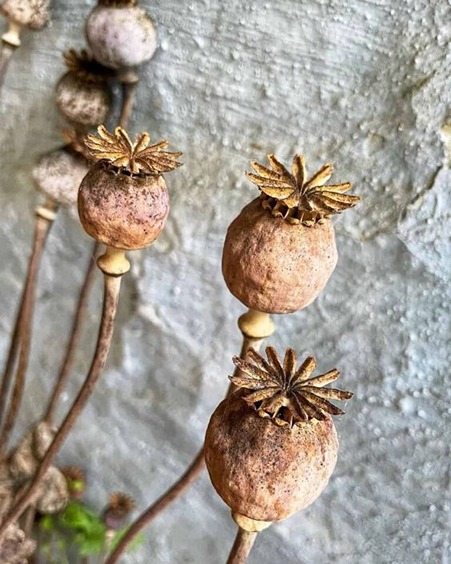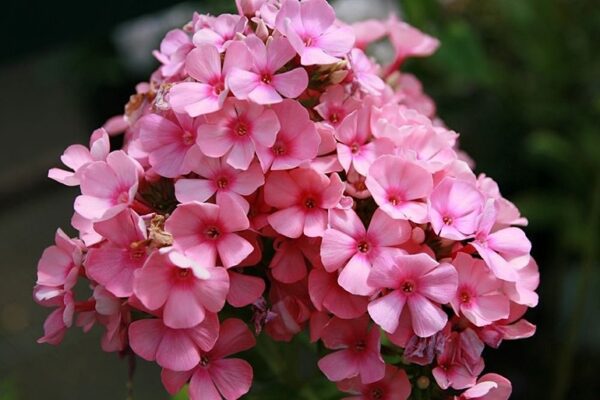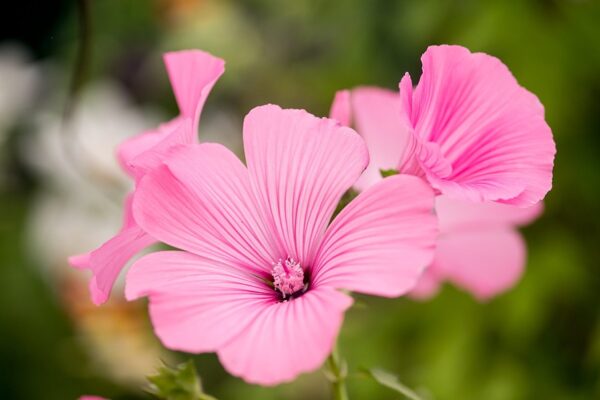How to Grow and Care for Rose of Sharon
Rose of Sharon (Hibiscus syriacus) is a captivating deciduous hibiscus species known for its abundant and breathtaking blooms in summer and fall. These remarkable flowers, resembling delicate paper, exhibit a captivating variety of colors, including mesmerizing bicolor combinations, while boasting a generous size of three inches in diameter. Notably, each blossom features a prominent stamen and often showcases a captivatingly dark-colored throat, adding to its allure.
In its natural state, Rose of Sharon possesses an elegant and upright vase-shaped form, adorned with lush medium to dark green foliage. Nevertheless, it is worth noting that this versatile shrub can be pruned and trained to assume a striking tree-like appearance with a single trunk. Whether planted in the delightful embrace of spring or the serene embrace of fall, Rose of Sharon exhibits a moderate growth rate, adding an impressive one to two feet in height each year, allowing it to flourish and establish its place in the garden landscape.
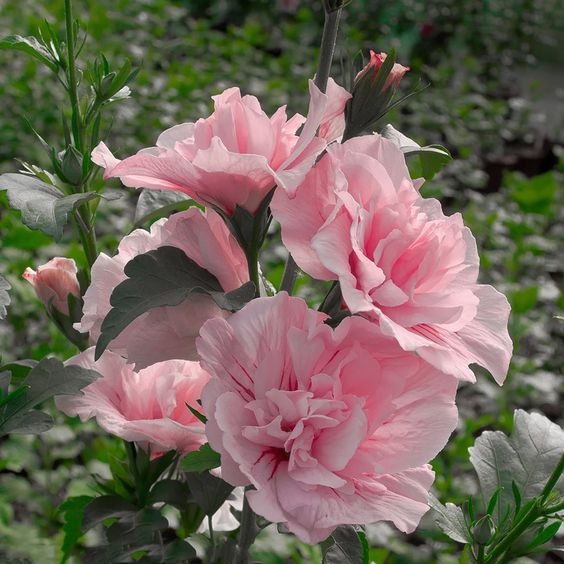
- Common Name: Rose of Sharon, shrub althea, rose mallow, Syrian mallow, Syrian hibiscus
- Botanical Name: Hibiscus syriacus
- Family: Malvaceae
- Plant Type: Shrub
- Mature Size: 8–12 ft. tall, 6–10 ft. wide
- Sun Exposure: Full, partial
- Soil Type: Moist, well-drained
- Soil pH: Acidic, neutral
- Bloom Time: Summer, fall
- Flower Color: Pink, purple, lavender, red, blue, white; often with dark throats
- Hardiness Zones: 5–8, USDA
- Native Area: Asia
Rose of Sharon Care
Rose of Sharon is a remarkably resilient shrub that thrives in diverse environments, exhibiting exceptional tolerance to urban conditions, high temperatures, humidity, impoverished soil, and even drought. Due to its robust nature, it is commonly employed as a striking specimen plant, an elegant hedge, or a captivating foundation plant, adding a touch of beauty to any landscape. It’s worth noting, however, that this shrub has a propensity for self-seeding, which necessitates the removal of seedlings if you wish to control the spread of Rose of Sharon in your garden.
When nurturing young Rose of Sharon plants, it is crucial to provide them with regular watering and nourishment to facilitate their establishment and growth. As the shrubs mature, their needs become more modest, requiring minimal care. While they exhibit a certain level of drought tolerance, it is advisable to water them during extended dry periods to ensure their well-being. Additionally, regular pruning is recommended to maintain the desired shape and size of the shrub, allowing for proper growth and enhancing its aesthetic appeal.
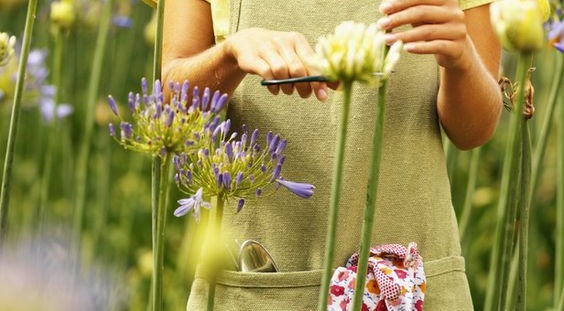
Light
Rose of Sharon thrives best in full sun, which translates to a minimum of six to eight hours of direct sunlight on a daily basis. Nevertheless, it can also tolerate and grow in areas with partial shade. It’s important to note, however, that excessive shade can impede the plant’s ability to produce abundant blooms and make it more susceptible to various diseases, particularly fungal infections.
Soil
Rose of Sharon exhibits versatility in its ability to thrive in various soil types, such as loamy, sandy, and clay soils. However, it shows a preference for a nutrient-rich soil that drains well, while maintaining a slightly acidic to neutral pH. Nonetheless, it also demonstrates tolerance towards slightly alkaline soil conditions.

Water
Rose of Sharon flourishes in soil that retains moisture, although mature shrubs possess a degree of tolerance to drought. It does not thrive in extreme conditions, whether excessively dry or overly wet. Thus, it is crucial to maintain a balance by avoiding complete soil dryness while ensuring that the shrub is not exposed to waterlogged conditions.
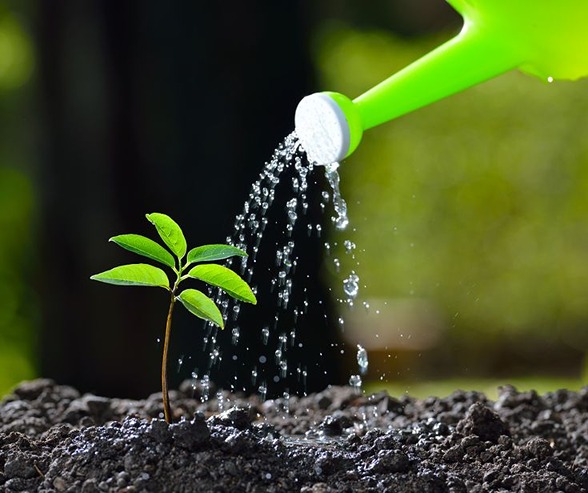
Humidity and Temperature
Although these shrubs have an affinity for heat, they possess the ability to endure harsh winters with temperatures dropping as low as -20 degrees Fahrenheit. Additionally, they can withstand high levels of humidity as long as there is proper air circulation. However, in the absence of sufficient air movement, humid conditions can foster the growth of fungi.
Fertilizer
While not obligatory for well-established shrubs, it is advisable to apply fertilizer, especially if the soil quality is subpar. Opt for a slow-release fertilizer during late winter or early spring, ensuring adherence to the instructions provided on the label. Alternatively, for those adhering to organic growing methods, incorporating an inch or two of compost into the soil around the root zone in the spring can be beneficial.
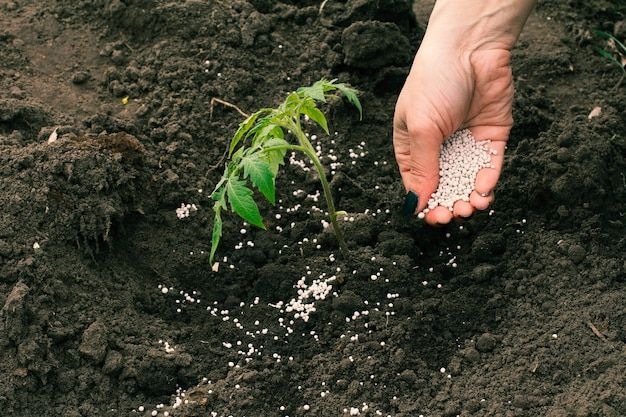
Types of Rose of Sharon
Blue Chiffon Hibiscus Syriacus: With a purple-blue tinge, the blooms of this cultivar display double flowers consisting of two layers of petals. Its flowering period extends from mid-summer to autumn, while it’s impressive height ranges between 8 to 12 feet, accompanied by a spread of six to ten feet.
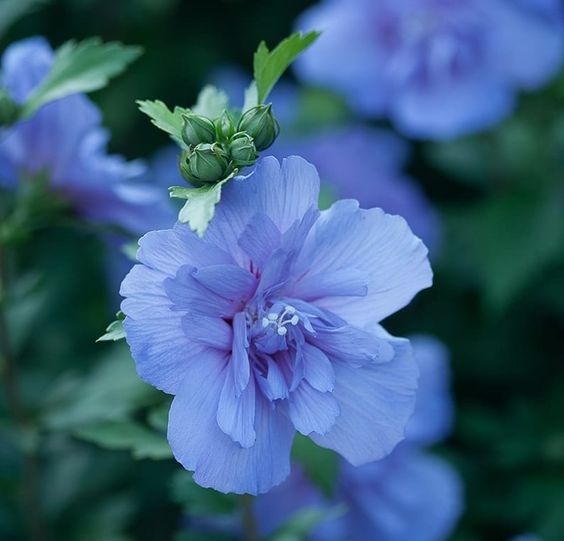
Sugar Tip Hibiscus Syriacus: The unique appeal of this cultivar lies in its variegated leaves adorned with creamy-white edging. It showcases pink double flowers and grows to a height of six to eight feet, with a width spanning four to six feet.
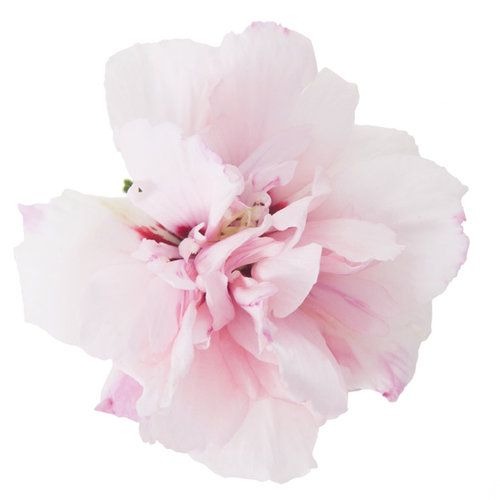
White Chiffon Hibiscus Syriacus: Distinguished by its pure white flowers without a contrasting throat, this variety exudes elegance. It reaches a height of six to eight feet and expands to a width of four to six feet.
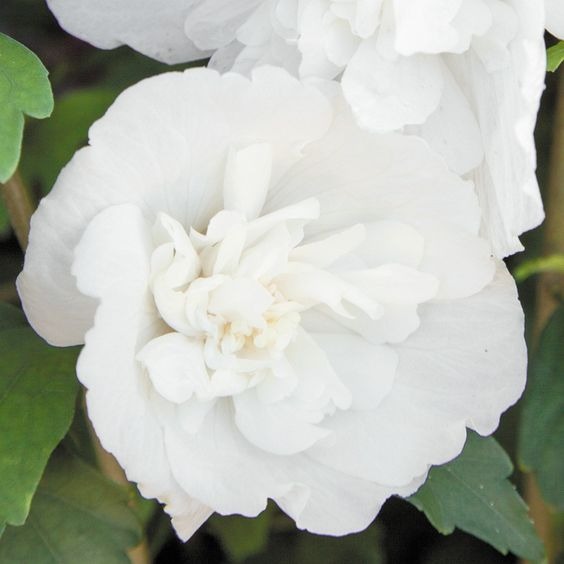
Red Heart Hibiscus Syriacus: This shrub’s ruffled flowers boast white petals with captivating dark red centers. A welcome feature for those seeking low-maintenance landscaping options, this cultivar is sterile, eliminating the need to remove any unwanted seedlings.
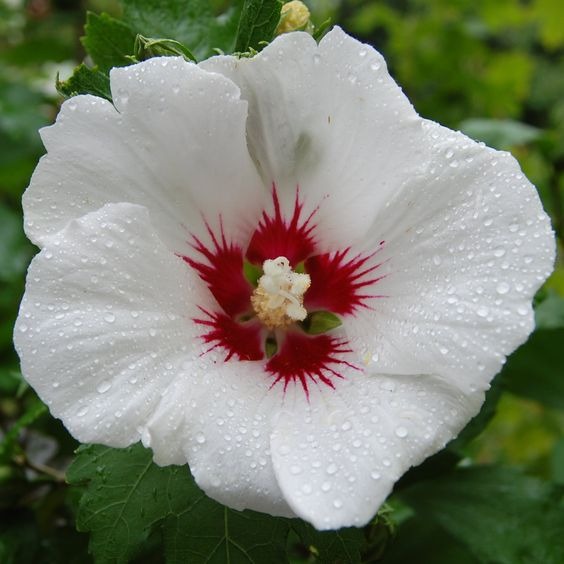
How to Prune
Rose of Sharon naturally grows in an appealing form, requiring minimal pruning to maintain its beauty. However, you have the option to trim its growth annually to achieve your preferred size and shape. It’s important to note that this shrub blooms on new wood, which means pruning should be done in late winter or early spring to avoid inadvertently removing flower buds that will blossom later in the season. By pruning the stem tips, you stimulate additional branching, resulting in an abundance of flowers. Additionally, promptly remove any damaged or diseased branches as they appear to ensure the overall health of the shrub.
How to Propagate
Taking stem cuttings is the preferred technique for propagating this shrub. It offers a cost-effective means of establishing new plants and allows you to preserve the characteristics of a specific variety that captivates you with its beautiful flowers. Midsummer presents the perfect opportunity to take these cuttings and propagate the shrub. To assist you in the process, here is a detailed step-by-step guide:
- Obtain a stem that is four to six inches long and approximately the width of a pencil. Eliminate the leaves from the lower half of the stem.
- Submerge the freshly cut end of the stem into a rooting hormone.
- Plant the lower one-third to one-half of the stem in a small container containing soilless potting mix. Ensure that the container has adequate drainage holes.
- Gently water the growing medium to achieve a light level of moisture.
- Cover the container with a transparent plastic bag.
- Position the container in a warm location that receives bright, indirect light.
- Regularly monitor the moisture level of the growing medium, adding more water if needed. Avoid excessive moisture that could lead to sogginess.
- After seven days, remove the plastic bag.
- Wait for one to two months and check for signs of root development. Gently tug on the stem; if you feel resistance, it indicates that the stem has successfully rooted. Additionally, the emergence of new leaf growth is an indicator of rooting.
- Once the stem has grown at least two inches, it is ready to be planted in your garden.
How to Grow From Seed
Rose of Sharon has a natural tendency to self-seed in the garden, but you can also propagate it from seeds. To start seeds indoors, it’s best to begin roughly 12 weeks before the anticipated last frost date in the spring. Begin by filling a container with soilless potting mix, ensuring it has good drainage. Plant each seed about a half inch deep in the soil, making sure to space them adequately.
After planting the seeds, lightly moisten the soil by misting it with water. It’s important to place the container in a well-lit area near a bright window that receives ample sunlight. Ideally, the room temperature should remain between 75 and 80 degrees Fahrenheit for optimal germination.
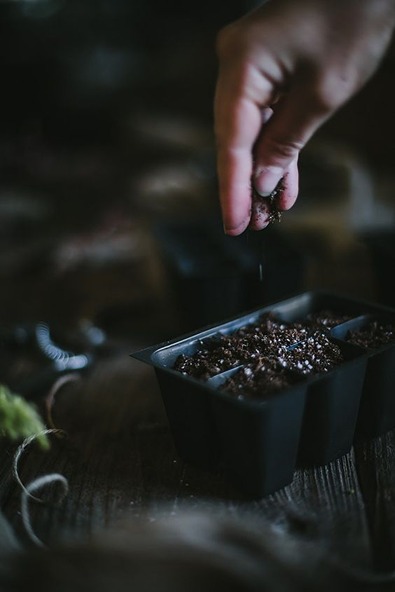
Overwintering
In its hardiness zones, Rose of Sharon generally doesn’t require any specific winter care. However, it is advisable to select a suitable location for the shrub that offers protection against harsh winter conditions, particularly strong, chilling, drying winds. This will help prevent excessive stress and damage to the plant.
For areas with colder climates within its hardiness zones, an additional measure you can take is to apply a layer of mulch around the base of the shrub. The mulch acts as insulation, helping to protect the roots and lower portion of the plant from the potential impact of extreme winter weather.
Common Pests
The primary pest concern for the Rose of Sharon shrub is the Japanese beetle. Luckily, these beetles are relatively easy to manage compared to other insect pests, as their noticeable size makes them more visible. This allows you to detect them before they cause significant harm to your plant.
The most convenient method of controlling Japanese beetles is by physically removing them from the shrub. You can either pick them off by hand or gently shake them off the plant and collect them in a container filled with soapy water. This simple technique is effective because the beetle breathes through its skin. When the soap coats their body, it obstructs their breathing and effectively suffocates them.
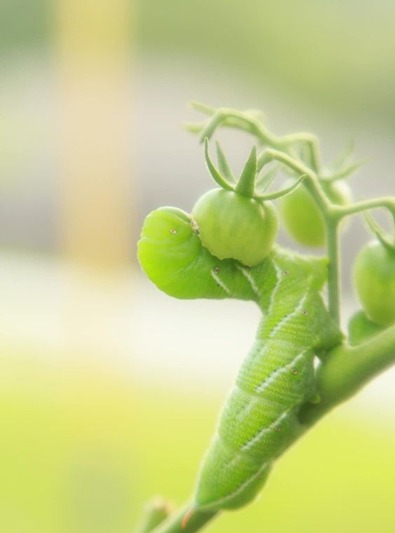
How to Get Bloom
Rose of Sharon reliably produces blooms year after year, provided it receives full sun exposure, along with adequate nutrients and soil moisture. These stunning flowers make their appearance in the middle of summer and can grace your garden until mid-fall or even the onset of frost. Each bloom showcases five slightly ruffled petals, with a prominent tubular stamen at the center, creating an eye-catching display. The alluring blossoms attract a variety of pollinators, including bees, butterflies, hummingbirds, and more.
To encourage continued blooming, deadheading, which involves removing spent blooms, is not essential. However, if you wish to prevent the formation of seed pods and limit the sprouting of seedlings, deadheading is recommended. This practice helps to maintain the desired appearance of your Rose of Sharon while ensuring its long-lasting beauty throughout the blooming season.
Common Problems
When provided with ideal conditions, this shrub flourishes and exhibits vigorous growth. However, when exposed to insufficient conditions, several common problems may emerge. It is important to be aware of these potential issues to ensure the continued health and vitality of the shrub.
By maintaining optimal conditions, such as proper sunlight, well-draining soil, and adequate moisture, you can help prevent these problems from occurring. Additionally, regular monitoring and timely intervention can address any issues that do arise. By being attentive to the needs of the shrub and promptly addressing any signs of stress or decline, you can cultivate a thriving and resilient plant.
Leaves Turning Yellow
Yellowing leaves on your shrub are often a result of excessive watering. To prevent this problem, it is important to ensure that your shrub is planted in well-draining soil and avoid waterlogged conditions. If your shrub is currently situated in an area with inadequate drainage, you may need to consider relocating it to a more suitable location. By taking these measures, you can mitigate the risk of yellowing leaves and promote the overall health of your shrub.
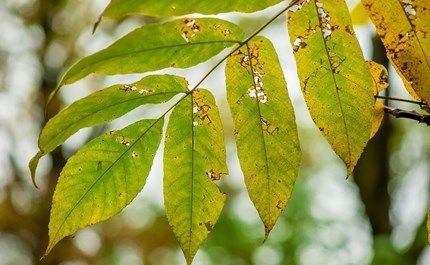
Not Blooming
There are several factors that can contribute to a shrub not blooming well or not blooming at all. One possibility is that you may have inadvertently pruned too late in the spring, removing flower buds in the process. Another potential cause is drought, which can suppress blooming. To mitigate this, it is important to provide your shrub with supplemental water during periods of extreme heat and dryness. Additionally, inadequate levels of phosphorus in the soil can lead to reduced flower production and smaller blooms. Conducting a soil test will help you identify any deficiencies and allow you to apply fertilizer accordingly.
